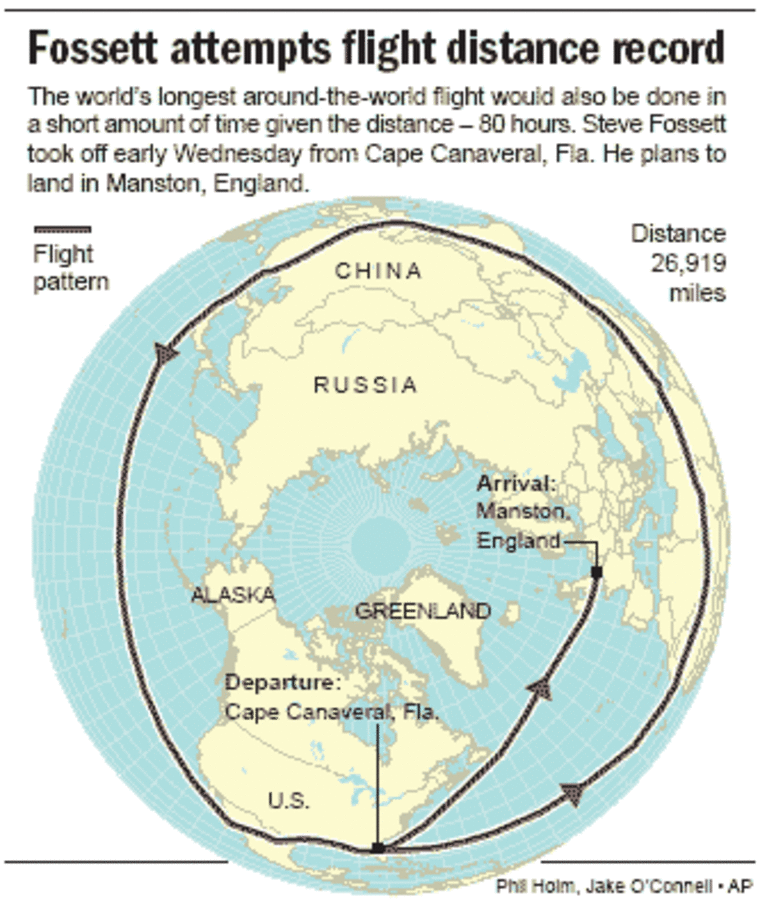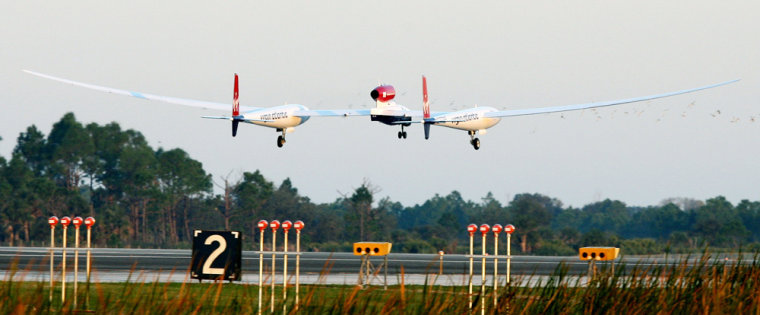After a white-knuckle takeoff, millionaire adventurer Steve Fossett soared across the Atlantic in a bony-looking experimental airplane Wednesday on a quest to break the 25,000-mile (40,000-kilometer) record for the world’s longest aircraft flight.
Early in the day, Fossett squeezed into the tiny cockpit, kissed his wife goodbye and set out on the planned, 3½-day nonstop journey, taking off from the Kennedy Space Center on a nearly three-mile (4.8-kilometer) runway that is normally used by space shuttles when they return to Earth.
His plane, the Virgin Atlantic GlobalFlyer, is made of lightweight carbon fiber and has a super fuel-efficient turbofan jet engine with a very high thrust-to-weight ratio.
The early-morning takeoff was free of technical problems like the major fuel leaks that had plagued Fossett’s nonstop solo flight around the globe last year and prevented him from taking off on Tuesday. Still, there were some hair-raising moments.
Two seabirds hit his plane during takeoff but caused no damage, and the aircraft lifted off about 1,500 feet (450 meters) farther down the runway than expected. The temperature in the cockpit reached 130 degrees Fahrenheit (54 degrees Celsius) at one point, causing instruments to temporarily stop working, before it cooled off.
“Takeoff was a bit scary, to say the least,” Fossett, 61, said hours later in a statement issued by his flight team. “I had to use most of the runway to get off the ground. This was particularly hairy, as I couldn’t have aborted even if I had wanted to.”
The birds apparently hit the leading edge of a wing and the nose of one of the fuel tanks, but those spots are well reinforced, said Jon Karkow, flight engineer.
Round the world, and then some
Fossett’s goal is a nearly 27,000-mile (43,470-kilometer) trip, once around the world and then across the Atlantic again, with a landing Saturday outside London. He was crossing Algeria as of 9:15 p.m. ET Wednesday, according to GlobalFlyer tracking data.

If Fossett is successful, the 80-hour voyage would break the airplane distance record of 24,987 miles (40,212 kilometers) set in 1986 by the lightweight Voyager aircraft piloted by Dick Rutan and Jeanna Yeager, as well as the balloon record of 25,361 miles (40,815 kilometers) set by the Breitling Orbiter 3 in 1999.
Fossett in 2002 became the first person to fly solo around the globe in a balloon, and last March he became the first person to circle the Earth solo in a plane without stopping or refueling. That flight, also made in the Virgin Atlantic GlobalFlyer, lasted 67 hours.
Both that venture and the latest flight were financed by Virgin Atlantic Airways founder Richard Branson.
Power naps and nutrition shakes
The aircraft has 13 fuel tanks under its spindly wings, which extend 114 feet (35 meters) tip to tip. Drag parachutes are used to help it descend from its average cruising altitude of about nine miles (14.5 kilometers) or slow it down from a top speed of 285 mph (460 kilometers per hour). At takeoff, the plane had 18,000 pounds (8,200 kilograms) of fuel.
Fossett is taking power naps no longer than five minutes each and drinking nutrition shakes while in the air. His plane is equipped with a parachute pack holding a one-man raft and a satellite rescue beacon, just in case.
Fossett went ahead with trip despite jetstreams that raised fears he might not make it to his eventual destination, Kent, England.
“Mr. Fossett decided it was worth trying,” Karkow said. “He’d rather be flying than sitting on the ground waiting for a good day.”
